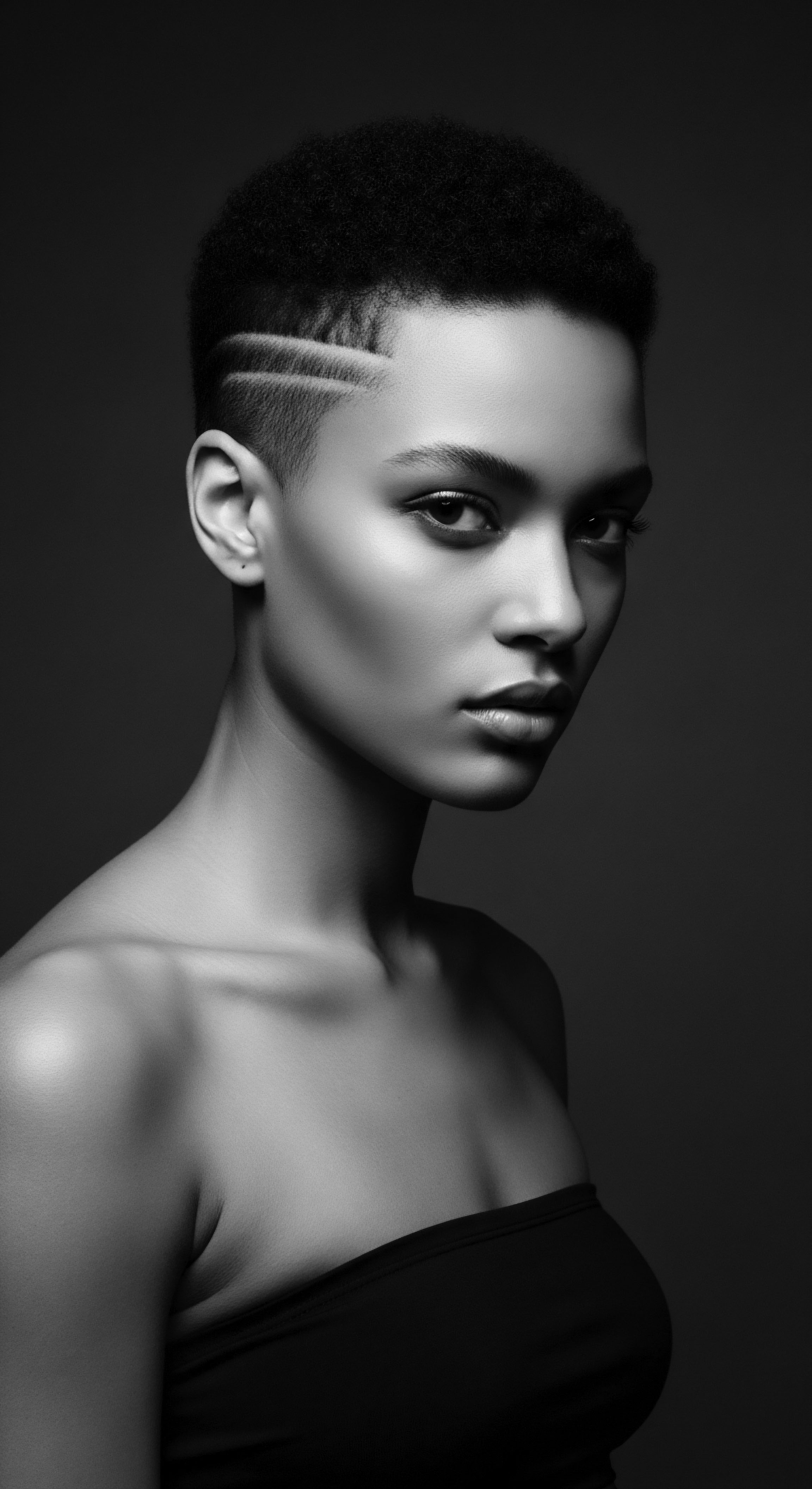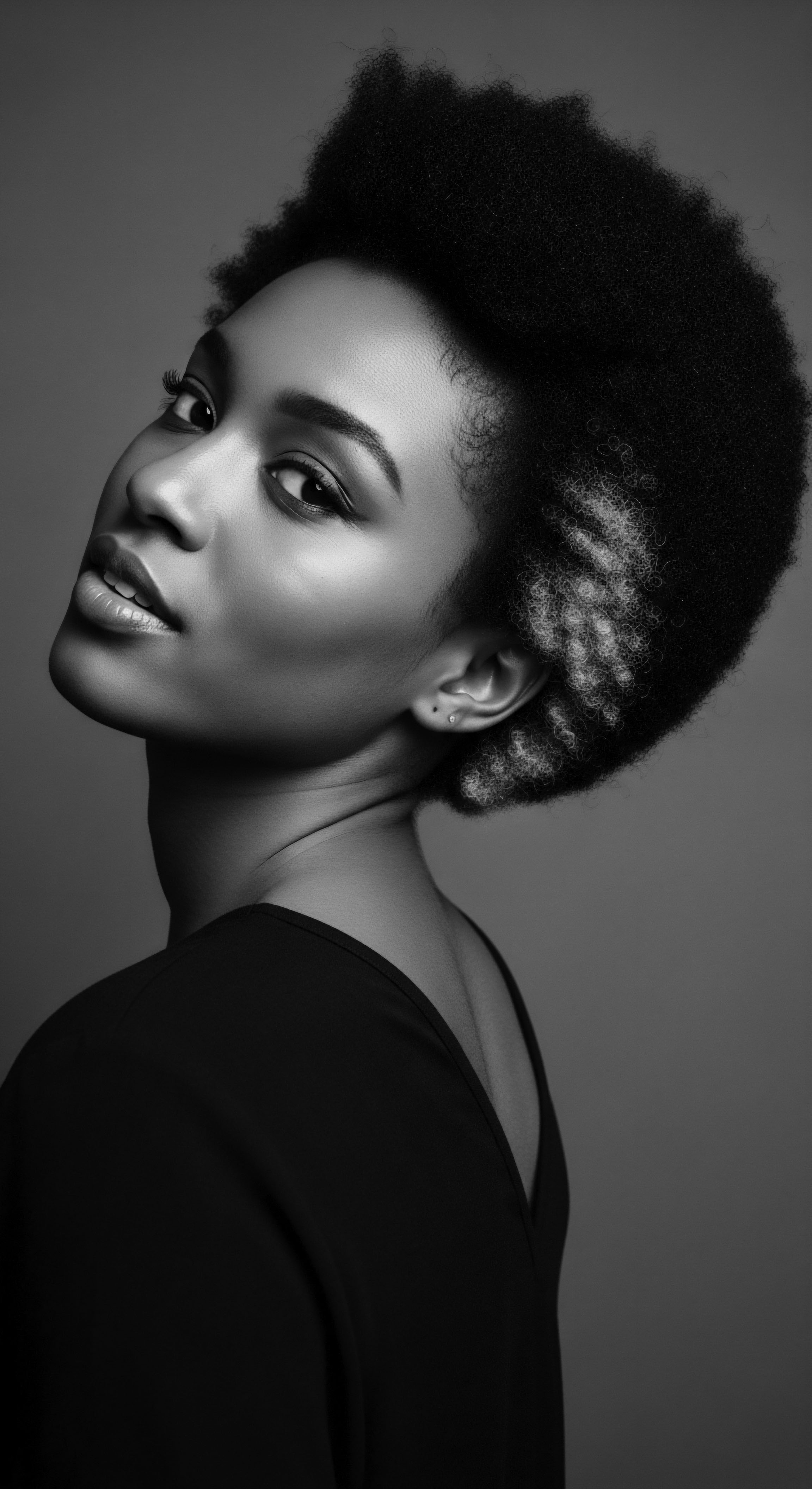
Roots
To gaze upon a single strand of hair, especially one born of ancient lineage, is to see more than keratin and pigment. It represents a living archive, a delicate scroll upon which centuries of care, communal wisdom, and environmental adaptation are inscribed. For those whose hair coils and bends in myriad ways, this story is particularly profound, a testament to resilience passed through generations. We embark upon a thoughtful exploration of how our ancestors understood their hair, how they tended it with profound respect, and the remarkable ways modern scientific understanding now illuminates the wisdom embedded in those time-honored practices for cleansing.
The very structure of textured hair—its elliptical cross-section, its varying diameter along the length, the helical path it takes from the scalp—presents unique considerations for cleansing. Unlike hair with a more uniform, round cross-section, the natural oils produced by the scalp, known as sebum, encounter difficulty traveling down the twists and turns of a textured strand. This inherent characteristic leaves textured hair often prone to dryness.
Ancient caretakers, with their keen observation of nature and deep understanding of their own physiology, recognized this innate quality. Their cleansing practices were not simply about removing impurities; they were also about preserving moisture and maintaining the hair’s integrity.
Understanding the intricate biology of textured hair reveals why ancestral cleansing methods prioritized hydration and gentle care.

Hair’s Elemental Blueprint
The foundational understanding of hair’s anatomy, even without electron microscopes, guided early care. They saw a need to cleanse without stripping, to purify while preserving. The hair shaft, a complex biological creation, possesses an outermost layer, the cuticle, a protective shield of overlapping cells. When this cuticle is smooth and lies flat, hair reflects light and resists external stressors.
Textured hair, by its very nature, can have a more lifted cuticle, making it more susceptible to moisture loss and tangles. Ancient cleansing ingredients, often derived directly from the earth and plants, interacted with this biology in ways our modern laboratories now confirm.

Ancestral Views on Hair Classification
While contemporary hair typing systems categorize curls and coils by shape and diameter, ancestral communities often viewed hair through a lens of origin, health, and spiritual significance. The distinctions were less about numerical patterns and more about the lived experience of the hair ❉ its strength, its vibrancy, its ability to hold a style, and its connection to communal identity. Hair was a marker of status, age, marital standing, and tribal affiliation. The methods of its care, including cleansing, were part of a holistic approach to wellbeing, deeply rooted in the cycles of nature and community life.
- African Hair Traditions ❉ From the intricate braiding practices of West African communities to the distinct protective styling found among Himba people, hair care was a daily, social ritual. Cleansing often involved clays and plant infusions.
- South Asian Practices ❉ Ayurvedic principles guided hair care in India for millennia, with emphasis on natural ingredients like amla and shikakai for holistic scalp and hair health.
- Indigenous American Wisdom ❉ Communities across the Americas utilized local botanicals, such as yucca root, recognizing their unique properties for gentle purification.

How Ancient Ingredients Addressed Hair Needs?
The scientific basis for many ancient textured hair cleansing ingredients often lies in the presence of naturally occurring compounds that act as surfactants, chelating agents, or emollients.
| Ancient Cleansing Agent Reetha (Soapnut) |
| Traditional Application and Origin Used extensively in India, typically crushed and boiled to create a soapy liquid for hair washing. |
| Underlying Scientific Mechanism Contains saponins, natural glucosides that lower water's surface tension, creating a mild lather that lifts dirt and oils. |
| Ancient Cleansing Agent Shikakai (Acacia concinna) |
| Traditional Application and Origin A staple in Ayurvedic hair care from the Indian subcontinent, often combined with other herbs. |
| Underlying Scientific Mechanism Rich in saponins, it acts as a gentle cleanser with a low pH, helping to maintain the scalp's acid mantle and protect against fungal growth. |
| Ancient Cleansing Agent Rhassoul Clay |
| Traditional Application and Origin Used for centuries by Berber people in North Africa for hair and body cleansing. |
| Underlying Scientific Mechanism Possesses a negative electrical charge, allowing it to adsorb positively charged impurities, excess sebum, and product buildup. Also provides minerals and helps balance scalp pH. |
| Ancient Cleansing Agent These ancestral choices reflect a deep observational knowledge, now validated by modern chemical understanding, that preserved hair health. |
The wisdom of ancestors, particularly those with textured hair, often sprang from direct observation of natural phenomena. They noticed which plants foamed when agitated in water, which clays softened the hair, and which concoctions eased scalp discomfort. This empirical knowledge, accumulated over generations, formed the bedrock of hair care. The modern lens of chemistry provides language to describe what these communities intuitively understood.
Many plants contain Saponins, compounds with a soap-like structure ❉ a water-loving head and an oil-loving tail. This structure allows them to surround oil and dirt particles, permitting water to rinse them away. Clays, on the other hand, often possess a net negative charge, drawing out positively charged impurities through ion exchange, while also imparting beneficial minerals to the hair and scalp.

Ritual
The act of cleansing hair, for ancestral communities with textured hair, transcended mere hygiene. It was a ritual, a deliberate practice woven into the rhythms of daily life and community celebration. These rituals were often communal affairs, fostering bonds as women braided, oiled, and cleansed one another’s hair.
This shared experience instilled a sense of belonging and reinforced cultural identity. The ingredients chosen for these rituals were not arbitrary; they were selected for their efficacy and their symbiotic relationship with the hair’s unique structure, a relationship now illuminated by scientific inquiry.
Consider the meticulous preparation of cleansing agents. In various parts of India, for example, the pods of the Reetha tree, or Soapnut, would be sun-dried, then crushed and soaked overnight, releasing their natural saponins into the water. This infusion, a cloudy liquid that created a gentle lather, became the cleansing medium.
This practice was not simply about a convenient foam; it was a measured process that extracted beneficial compounds without resorting to harsh chemical treatments. The resulting wash respected the delicate nature of textured hair, helping to avoid the dryness and breakage often associated with strong detergents.
Traditional cleansing practices extended beyond sanitation, shaping communal identity and honoring the distinct requirements of textured hair.

Why Cleansing Matters for Textured Hair Heritage?
The coiled architecture of textured hair, with its inherent tendency towards dryness, makes traditional synthetic cleansers, laden with harsh sulfates, particularly damaging. Sulfates, highly effective detergents, strip natural sebum from the hair, leading to frizz, brittleness, and breakage. Ancestral cleansing ingredients, conversely, offered a milder approach. Plants rich in saponins, such as Shikakai, provide cleansing without excessive stripping of these vital oils.
Modern scientific studies confirm that saponin-based cleansers, with their milder surfactant properties, offer effective cleaning while minimizing disruption to the hair’s natural lipid barrier. (Meshram & Kumar, 2021)
The clay cleansing traditions found across North Africa provide another window into this gentle yet effective approach. Rhassoul clay, for example, forms a colloidal suspension when mixed with water. Its mineral composition, rich in magnesium, silica, and calcium, contributes to its adsorptive properties. When applied to hair, the clay’s negatively charged particles attract positively charged impurities, like dirt and product buildup, lifting them away without stripping the hair of its essential moisture.
This natural ion exchange cleanses the scalp and strands while simultaneously imparting beneficial minerals and helping to balance the scalp’s pH, which is crucial for healthy hair growth. (Abderrahmane, 2024)

Cleansing and Styling Foundations
The connection between cleansing and styling in ancestral practices for textured hair cannot be overstated. A clean, properly conditioned strand provided the optimal foundation for elaborate, often protective, hairstyles.
- Hair Threading ❉ In various African cultures, hair threading, a method of stretching and protecting hair using cotton or wool, was often performed on freshly cleansed and detangled hair. The subtle conditioning provided by natural cleansers made the hair pliable for this intricate work.
- Braiding and Coiling ❉ The cleanliness and hydration afforded by traditional cleansing methods meant that braids, twists, and coils would hold their shape longer, reflecting the aesthetic and social values of the community.
- Oil Infusion ❉ After a gentle cleansing, many traditions involved the application of nourishing oils—coconut, shea, castor—which were better absorbed by a scalp and hair that were cleansed but not parched. (Lau, 2023)
Consider the historical example of the use of plant-based cleansing agents in the Indian subcontinent. The Ayurvedic System, dating back thousands of years, regularly incorporated botanical ingredients like amla (Indian gooseberry), reetha (soapnut), and shikakai (soap pod) into hair cleansing rituals. These plants, often used in combination, provided cleansing, conditioning, and scalp treatment. Modern scientific analysis has confirmed that these ingredients contain saponins, natural surfactants that create a gentle lather to wash away impurities without harsh stripping.
Amla, beyond its cleansing properties through mild saponins, is rich in Vitamin C and polyphenols, known to strengthen hair follicles and stimulate dermal papilla cells, supporting hair growth (Singh et al. 2012; Sharma et al. 2017). This ancient knowledge, transmitted orally and through texts like the Charaka Samhita and Sushruta Samhita, stands as a powerful demonstration of how communities intuitively leveraged the scientific properties of plants long before contemporary chemistry provided the vocabulary to describe them.
The art of styling textured hair, whether for daily wear or ceremonial occasions, relied heavily on the preceding cleansing and conditioning steps. The pliability of hair, its ability to retain moisture, and its overall health were directly affected by the cleansing agents chosen. A strand that had been gently purified by plant-derived saponins or mineral-rich clays was a strand prepared to receive and respond to the shaping hands of the stylist, holding its form with dignity and grace.

Relay
The enduring legacy of ancient textured hair cleansing ingredients transcends mere historical interest; it offers a profound opportunity for contemporary understanding, bridging ancestral wisdom with modern scientific rigor. The relay of this knowledge across generations, often through oral traditions and communal practices, has brought forth effective methods for scalp and hair purification that respect the unique biomechanical characteristics of coiled and curly strands. This deep cultural intelligence, once dismissed by dominant narratives, now finds validation within the precincts of scientific laboratories and peer-reviewed journals.

How Do Saponins Work?
At the core of many traditional plant-based cleansers, we find Saponins. These glycosides, found abundantly in plants like soapnuts (Sapindus mukorossi) and shikakai (Acacia concinna), possess a molecular structure that enables their cleansing action. A saponin molecule consists of a hydrophobic (water-repelling) aglycone portion and a hydrophilic (water-attracting) sugar chain. When these molecules dissolve in water, they arrange themselves at the interface between water and oil/dirt particles.
The hydrophobic tails immerse themselves in the oil, while the hydrophilic heads extend into the water. This arrangement forms tiny spherical structures called micelles. These micelles encapsulate oil and dirt, allowing them to be suspended in water and subsequently rinsed away. (Meshram & Kumar, 2021)
The efficacy of saponins, while less aggressive than synthetic surfactants like sulfates, is precisely what makes them suitable for textured hair. Sulfates, with their strong anionic charge, can create excessive negative charges on the hair surface, leading to frizz and friction. Saponin-based cleansers, on the other hand, provide a gentler cleansing action, minimizing the stripping of the hair’s natural oils and helping to maintain the integrity of the cuticle layer.
This gentleness is a significant reason why these ancestral ingredients supported hair health over lifetimes, allowing hair to retain its natural moisture and tensile strength. (Meshram & Kumar, 2021)

The Adsorptive Power of Clays
Clays, particularly those like rhassoul and bentonite, represent another significant class of ancient cleansing agents for textured hair. Their scientific power lies in their Adsorptive Properties and mineral composition. Clays are composed of fine mineral particles, primarily silicates, which exhibit a layered structure. Many cleansing clays, such as bentonite and rhassoul, have a net negative charge due to isomorphic substitution within their mineral lattice.
This negative charge allows them to attract and bind positively charged ions, including dirt, excess sebum, toxins, and product buildup. (Masaoudi et al. 2024)
The profound efficacy of traditional hair cleansing ingredients, from plant saponins to mineral-rich clays, finds its explanation in their gentle, yet powerful, chemical interactions with the hair and scalp.
Beyond their adsorptive capabilities, clays also contribute minerals such as silica, magnesium, calcium, and iron directly to the scalp and hair shaft. These minerals play roles in hair strength and health. Additionally, clays often possess a slightly alkaline pH, which can assist in opening the hair cuticle for better product penetration during the cleansing process. When followed by an acidic rinse, often a traditional practice itself (e.g.
vinegar rinses), the cuticle can be sealed, resulting in smoother, shinier hair. This careful balance of pH, understood empirically by ancestors, speaks to a sophisticated, holistic approach to hair cleansing and maintenance.

Natural Cleansers and Scalp Health
A scientific examination of ancestral cleansing practices reveals a consistent focus on scalp health, an approach modern dermatology has increasingly emphasized. A healthy scalp forms the foundation for healthy hair growth. Many traditional cleansing ingredients possessed properties that extended beyond mere dirt removal.
- Antifungal Properties ❉ Shikakai, for instance, exhibits antifungal compounds that contribute to maintaining scalp pH balance and discouraging fungal overgrowth associated with dandruff. (Kaur, 2024)
- Anti-Inflammatory Effects ❉ Ingredients like aloe vera, widely used in various indigenous communities, offer soothing and anti-inflammatory benefits, calming irritated scalps.
- Nutrient Delivery ❉ Some traditional preparations, like those incorporating Amla, provided direct nutrients (like Vitamin C) that support collagen production, critical for hair follicle health and growth regulation. (Kaur, 2024)
The traditional knowledge of ingredient combinations also speaks to an intuitive understanding of synergistic effects. The blending of amla, reetha, and shikakai in Ayurvedic practices provides a comprehensive cleansing system. Reetha delivers the primary saponin cleansing action, shikakai balances pH and acts as a mild conditioner, and amla offers antioxidant protection and Vitamin C, all working in concert to cleanse, condition, and nourish the scalp and hair. This layered approach, refined over countless generations, presents a scientific model for effective, gentle cleansing suited to the specific needs of textured hair.

Reflection
To consider the scientific basis for ancient textured hair cleansing ingredients is to bear witness to a remarkable interplay of ancestral wisdom, environmental knowledge, and intuitive understanding of biology. Each carefully chosen leaf, root, or mineral speaks volumes of a profound connection between communities and the earth that sustained them. These practices were not just about cleanliness; they were rituals of identity, moments of communal bond, and acts of profound self-care, a testament to the Soul of a Strand that pulsed with the life force of generations.
The whispers of history tell us that the efficacy observed in bygone eras was no accident. The earth provided solutions, and observant hands learned to harness the mild surfactants in plants, the adsorptive capabilities of clays, and the conditioning touch of botanical infusions. As we navigate contemporary hair care, the heritage of textured hair cleansing stands as a guiding star, illuminating pathways back to sustainable, deeply nourishing practices.
Our ongoing research into these ancient methods offers more than scientific validation; it fosters a renewed respect for the ingenuity and resilience of our forebears, whose meticulous attention to hair health built a living library of care, strand by luminous strand. This legacy continues to shape our understanding, guiding us toward a future where textured hair is celebrated in all its forms, its heritage honored with every gentle cleanse.

References
- Abderrahmane, M. (2024). The Ancient Haircare Secret That’s Backed By Modern Science. Rolling Out.
- Kaur, P. (2024). How to Use Amla, Reetha, Shikakai Powder for Hair Care?
- Lau, H. (2023). The Legacy of Lathers ❉ Tracing the Historical Use of Natural Ingredients in Hair Cleansing.
- Masaoudi, I. Cherkaoui, R. Tahri, M. & Amchra, F. (2024). Indigenous knowledge applied to the use of clays for cosmetic purposes in Africa ❉ An overview. Sabinet African Journals.
- Meshram, P. D. & Kumar, S. (2021). Comparative study of saponin for surfactant properties and potential application in personal care products. Sci-Hub.
- MDPI. (2019). Hair Care Cosmetics ❉ From Traditional Shampoo to Solid Clay and Herbal Shampoo, A Review.
- MDPI. (2024). Cosmetopoeia of African Plants in Hair Treatment and Care ❉ Topical Nutrition and the Antidiabetic Connection?
- Ramakrishnan, T. & Gupta, D. (2022). Reetha ❉ Benefits, Precautions and Dosage. 1mg.
- Singh, M. & Devi, S. (2024). Preparation and evaluation of herbal hair growth and hair cleansing shampoo.
- Smiechowski, J. (2022). 4 Ways Bentonite Clay Beautifies Hair. Redmond Life.
- Soni, D. & Gupta, D. (2022). Shikakai ❉ Benefits, Precautions and Dosage. 1mg.
- Soni, D. & Deka, M. (2022). Reetha ❉ Benefits, Precautions and Dosage. 1mg.
- The Earth Collective. (2024). Key Ingredients in Hair Cleansers and Their Benefits.
- Vertex AI Search. (2024). Shampoo, story of a modern tradition. Insight Professional.
